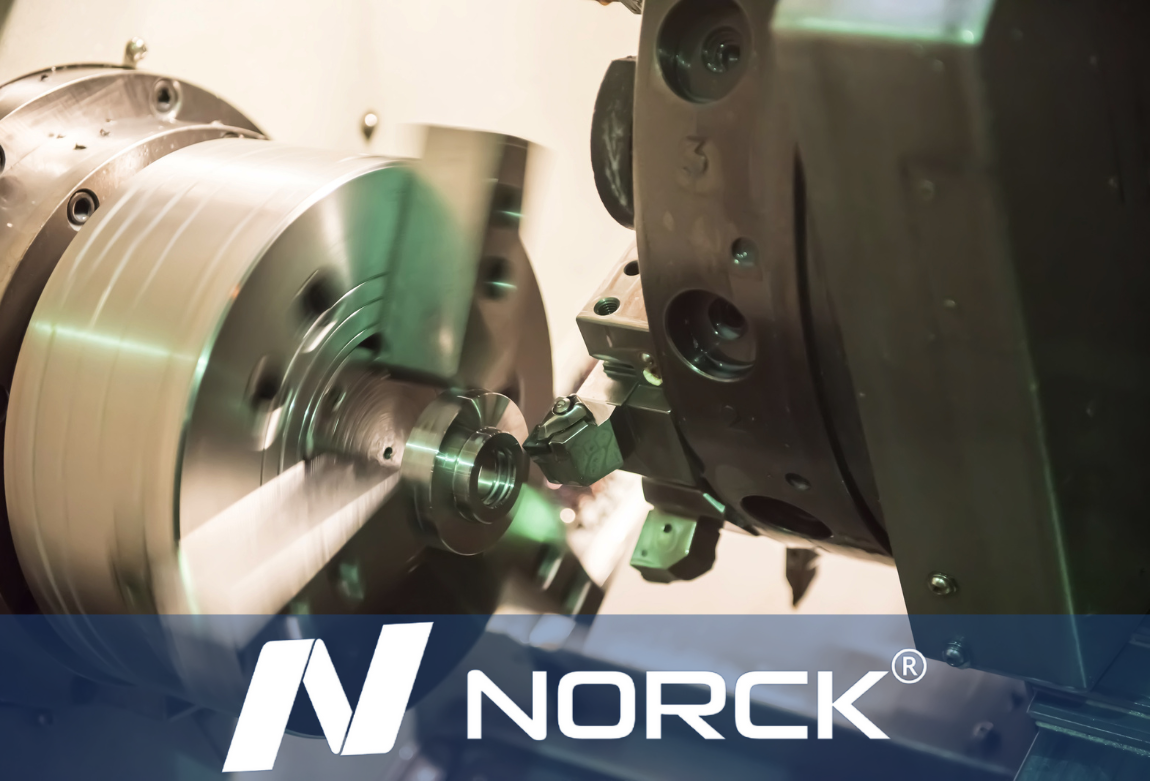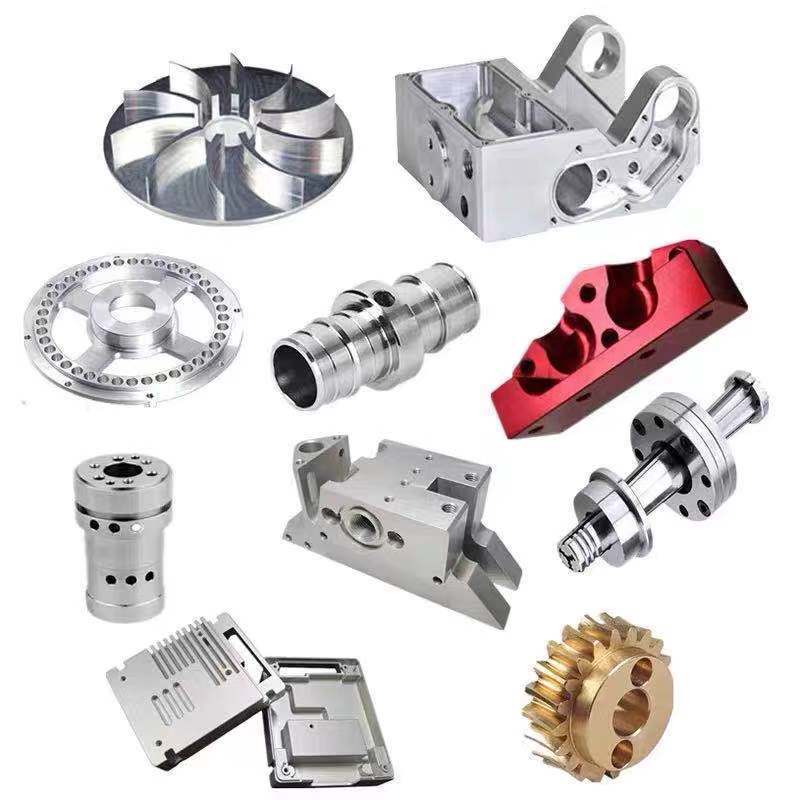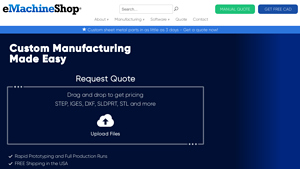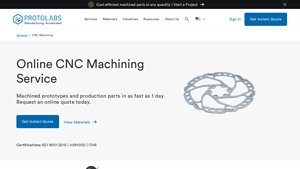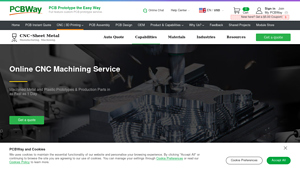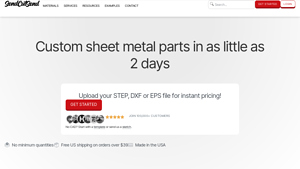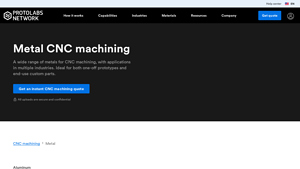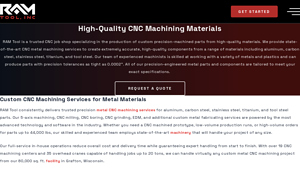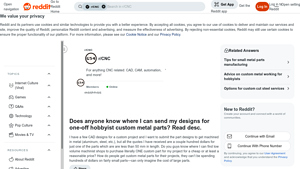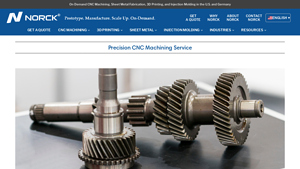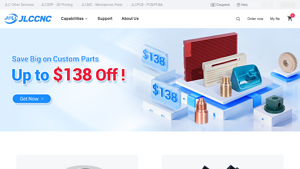Custom Metal Cnc Guide: Type, Cost, Top List…
Introduction: Navigating the Global Market for custom metal cnc
In the increasingly competitive landscape of global manufacturing, sourcing high-quality custom metal CNC components can present significant challenges for B2B buyers. From navigating complex supply chains to ensuring compliance with international quality standards, the process can be daunting. This guide aims to demystify the world of custom metal CNC machining by providing a comprehensive overview of the various types of CNC services available, their applications across industries, and effective strategies for vetting suppliers.
International B2B buyers, particularly those from Africa, South America, the Middle East, and Europe, will find valuable insights into cost considerations, turnaround times, and the importance of certifications such as ISO and ITAR. Understanding these factors is crucial for making informed purchasing decisions that align with specific project requirements and industry standards.
This guide empowers businesses to streamline their sourcing processes, minimize risks, and ultimately enhance their competitive edge in the global market. By leveraging the insights provided, buyers can confidently engage with suppliers, ensuring they receive the best value and quality for their custom metal CNC needs.
Understanding custom metal cnc Types and Variations
| Type Name | Key Distinguishing Features | Primary B2B Applications | Brief Pros & Cons for Buyers |
|---|---|---|---|
| CNC Milling | Utilizes rotating cutting tools for material removal in multiple axes. | Aerospace, automotive, and medical devices. | Pros: High precision, complex geometries. Cons: Longer setup time compared to turning. |
| CNC Turning | Involves rotating the workpiece against a stationary cutting tool. | Shaft components, fittings, and fasteners. | Pros: Efficient for cylindrical parts, high-speed production. Cons: Limited to round shapes. |
| CNC Routing | Uses a router to cut various materials, suitable for both 2D and 3D shapes. | Signage, furniture, and custom parts. | Pros: Versatile for different materials, ideal for large sheets. Cons: Less precise than milling. |
| CNC Laser Cutting | Employs a laser to cut through materials with high precision. | Sheet metal fabrication and prototyping. | Pros: Clean cuts, minimal material waste. Cons: Limited thickness of materials. |
| CNC Waterjet Cutting | Uses high-pressure water jets to cut through materials, including metals. | Aerospace components, thick materials. | Pros: No heat-affected zone, cuts thick materials. Cons: Slower than laser cutting. |
What are the characteristics and suitability of CNC Milling?
CNC milling is characterized by its ability to create intricate designs and complex geometries through the use of rotating cutting tools. It operates on multiple axes, which allows for a high degree of precision and versatility in part design. This method is particularly suitable for industries requiring high tolerances and detailed features, such as aerospace and medical device manufacturing. When purchasing CNC milling services, B2B buyers should consider the machine’s capabilities, the range of materials offered, and the supplier’s certification standards to ensure compliance with industry regulations.
How does CNC Turning differ from other types of CNC machining?
CNC turning is distinct in that it involves the rotation of the workpiece against a stationary cutting tool, making it highly efficient for producing cylindrical shapes. This method is widely used for manufacturing components like shafts and fittings, where uniformity and speed are critical. B2B buyers should focus on the supplier’s ability to handle specific dimensions and tolerances, as well as the turnaround time for production. Understanding the limitations of CNC turning, such as its applicability primarily to round shapes, can help buyers make informed decisions.
What makes CNC Routing a versatile option for custom parts?
CNC routing stands out for its versatility in cutting various materials, including wood, plastics, and metals, making it ideal for applications ranging from signage to furniture. This method allows for both 2D and 3D cutting, accommodating a wide range of design requirements. For B2B buyers, it’s essential to evaluate the router’s capabilities in terms of material thickness and complexity of shapes. Additionally, considering the supplier’s experience with specific applications can ensure that the final products meet quality and design expectations.
In what scenarios is CNC Laser Cutting preferred?
CNC laser cutting is preferred for its precision and ability to create clean cuts with minimal material waste. It is particularly effective for sheet metal fabrication and intricate designs where fine detail is essential. B2B buyers should assess the types of materials that can be cut and the maximum thickness capabilities of the laser cutter. Understanding the trade-offs, such as the slower cutting speed for thicker materials, can help buyers choose the right method for their project needs.
Why is CNC Waterjet Cutting advantageous for certain applications?
CNC waterjet cutting is advantageous for its ability to cut through thick materials without creating a heat-affected zone, making it suitable for sensitive materials. This method is often used in aerospace applications where material integrity is paramount. Buyers should consider the waterjet’s cutting speed and the range of materials it can handle. Additionally, understanding the cost implications of using waterjet cutting compared to other methods can help in making budget-conscious decisions.
Key Industrial Applications of custom metal cnc
| Industry/Sector | Specific Application of custom metal cnc | Value/Benefit for the Business | Key Sourcing Considerations for this Application |
|---|---|---|---|
| Aerospace | Manufacturing of complex engine components | High precision and reliability are critical for safety and performance. | Certification compliance (e.g., AS9100D), material traceability, and quick lead times. |
| Medical Devices | Production of surgical instruments and implants | Ensures high accuracy and biocompatibility for patient safety. | ISO certifications, custom tolerances, and rapid prototyping capabilities. |
| Automotive | Creation of custom parts for electric vehicles | Supports innovation in design and enhances vehicle performance. | Material specifications, volume flexibility, and adherence to industry standards. |
| Electronics | Fabrication of heat sinks and enclosures | Improves thermal management and protects sensitive components. | Precision machining, surface finish requirements, and rapid turnaround for prototypes. |
| Robotics | Development of custom robotic arms and components | Enhances automation capabilities and operational efficiency. | Tolerance specifications, material selection for durability, and integration with existing systems. |
How is Custom Metal CNC Used in the Aerospace Industry?
In the aerospace sector, custom metal CNC machining is employed to produce intricate engine components, structural parts, and landing gear assemblies. The precision required in these applications is paramount, as even minor deviations can lead to failures. International buyers must ensure that suppliers are compliant with rigorous standards such as AS9100D and can provide material traceability and quality certifications. The ability to rapidly prototype and produce parts can significantly reduce lead times and enable faster project timelines.
What Role Does Custom Metal CNC Play in Medical Device Manufacturing?
Custom metal CNC machining is critical in the medical device industry for crafting surgical instruments, implants, and diagnostic equipment. The stringent requirements for accuracy and biocompatibility are essential for patient safety and regulatory compliance. Buyers in this sector should prioritize suppliers with ISO certifications and those capable of accommodating custom tolerances. Additionally, rapid prototyping services can facilitate quick iterations in design, allowing for faster market entry.
How is Custom Metal CNC Transforming the Automotive Sector?
The automotive industry leverages custom metal CNC machining to create specialized parts for electric vehicles, such as battery housings and motor components. This technology supports the industry’s shift towards innovation and sustainability by enabling the production of lightweight and efficient designs. When sourcing, businesses should consider the supplier’s ability to meet specific material specifications, maintain flexibility in production volumes, and comply with automotive standards.
In What Ways Does Custom Metal CNC Benefit Electronics Manufacturing?
In electronics, custom metal CNC machining is used to fabricate components like heat sinks, enclosures, and mounting brackets. These parts are essential for effective thermal management and protecting sensitive electronic components. Buyers should focus on suppliers that offer precision machining capabilities and can meet specific surface finish requirements. Quick turnaround times for prototypes are also crucial to keep pace with the fast-evolving electronics market.
How is Custom Metal CNC Enhancing Robotics Development?
The robotics industry utilizes custom metal CNC machining to produce components such as robotic arms, gears, and frames. This technology allows for the creation of highly tailored parts that improve automation efficiency and performance. When sourcing these components, businesses should emphasize the importance of tight tolerance specifications and material choices that ensure durability and reliability. Additionally, suppliers should demonstrate experience in integrating custom parts with existing robotic systems.
3 Common User Pain Points for ‘custom metal cnc’ & Their Solutions
Scenario 1: Navigating Complex Specifications for Precision Parts
The Problem: B2B buyers often face the challenge of translating complex design specifications into effective manufacturing instructions. When dealing with custom metal CNC machining, the stakes are high, especially in industries such as aerospace or medical devices, where precision is critical. Buyers may struggle with ensuring that their CAD files are compatible with the manufacturer’s capabilities, leading to miscommunication, delays, or even the production of unusable parts. Additionally, the lack of clarity regarding tolerances and finishes can result in costly rework or scrapped materials.
The Solution: To overcome this hurdle, buyers should engage in detailed consultations with their CNC machining partners. Start by clearly defining the project requirements, including material specifications, tolerances, and surface finishes. Use industry-standard guidelines, such as those from the American National Standards Institute (ANSI) or the International Organization for Standardization (ISO), to specify tolerances and surface roughness values. Consider utilizing advanced software that can simulate the machining process and provide design feedback. Most reputable CNC service providers offer design-for-manufacturability (DFM) reviews, where engineers can assist in refining designs for optimal machining. This proactive approach not only mitigates risks but also enhances collaboration, ensuring that the final product meets all specifications and industry standards.
Scenario 2: Managing Cost and Lead Time Pressures
The Problem: In today’s fast-paced market, B2B buyers often face immense pressure to reduce costs and meet tight deadlines. Custom metal CNC machining can be perceived as expensive, especially for small batch sizes, which may lead buyers to compromise on quality or choose less suitable manufacturing methods. Additionally, buyers may experience frustration when lead times are extended due to backlogs, material shortages, or inefficient production processes.
The Solution: To effectively manage costs and lead times, buyers should adopt a strategic sourcing approach. Begin by evaluating multiple CNC machining suppliers to compare quotes and production capabilities. Look for providers that offer instant online quoting systems, which can significantly reduce the time spent on obtaining quotes. Additionally, consider establishing long-term partnerships with selected suppliers; this can lead to better pricing and priority scheduling for urgent orders. Implementing lean manufacturing principles can also be beneficial—encourage suppliers to adopt just-in-time practices to minimize inventory costs and reduce lead times. Finally, consider investing in technology that allows for rapid prototyping, which can facilitate faster iterations and ultimately lead to quicker market entry.
Scenario 3: Ensuring Quality and Compliance in Production
The Problem: Quality assurance is a significant concern for B2B buyers sourcing custom metal CNC parts, particularly in regulated industries like medical and aerospace. Buyers may worry about the consistency of manufacturing processes and the compliance of parts with industry standards. Issues such as subpar material quality, insufficient inspection protocols, or inadequate documentation can lead to failures in the field, resulting in costly recalls and reputational damage.
The Solution: To ensure high-quality outputs, buyers should prioritize suppliers that adhere to recognized quality management certifications, such as ISO 9001 or AS9100. It is essential to request documentation that verifies material certifications and quality control processes. Establish clear inspection criteria and require suppliers to provide detailed inspection reports for critical components. Additionally, consider implementing regular audits of your suppliers’ facilities to ensure compliance with your standards and regulations. Leveraging advanced technologies like CNC machines equipped with in-process measurement systems can further enhance quality assurance by allowing for real-time monitoring of part dimensions during production. By emphasizing quality and compliance from the outset, buyers can significantly reduce risks associated with defective parts and maintain high levels of customer satisfaction.
Strategic Material Selection Guide for custom metal cnc
What Are the Key Properties of Aluminum for Custom Metal CNC Machining?
Aluminum is a highly favored material in custom CNC machining due to its excellent strength-to-weight ratio and corrosion resistance. It typically performs well under a range of temperatures and pressures, making it suitable for various applications, including aerospace and automotive components. Aluminum alloys, such as 6061 and 7075, are particularly noted for their machinability and formability, allowing for complex designs.
Pros and Cons of Using Aluminum in CNC Machining
The primary advantages of aluminum include its lightweight nature, which reduces shipping costs and energy consumption in applications, and its resistance to corrosion, which extends the lifespan of the final product. However, aluminum can be more expensive than some other materials, and its lower strength compared to steel may limit its use in high-stress applications. Additionally, specific machining techniques may be required to achieve desired tolerances, which can increase manufacturing complexity.
How Does Stainless Steel Perform in Custom CNC Machining?
Stainless steel is renowned for its durability and corrosion resistance, making it an ideal choice for applications in harsh environments, such as marine and chemical processing. It can withstand high temperatures and pressures, ensuring reliability in demanding conditions. Common grades used in CNC machining include 304 and 316, each offering unique properties that cater to specific applications.
Pros and Cons of Utilizing Stainless Steel
The key advantage of stainless steel is its exceptional strength and resistance to rust and corrosion, which makes it suitable for long-term use in challenging environments. However, it is generally more expensive than aluminum and can be more challenging to machine due to its hardness, potentially leading to longer lead times and increased costs. Additionally, the weight of stainless steel can lead to higher shipping costs.
What Are the Benefits of Using Brass in CNC Machining?
Brass, an alloy of copper and zinc, is often selected for its excellent machinability and aesthetic appeal. It is particularly effective in applications requiring electrical conductivity and corrosion resistance, such as in plumbing and electrical components. Brass can perform well under moderate temperatures and pressures, making it suitable for various industrial applications.
Pros and Cons of Brass in CNC Machining
Brass offers several advantages, including ease of machining, which can lead to lower manufacturing costs and faster production times. Its attractive finish is also a significant plus for consumer-facing products. However, brass can be more expensive than aluminum and may not be suitable for high-stress applications due to its lower strength. Additionally, brass can tarnish over time, requiring maintenance to preserve its appearance.
What Should International Buyers Consider When Choosing Titanium for CNC Machining?
Titanium is a premium material known for its high strength-to-weight ratio and exceptional corrosion resistance, making it ideal for aerospace, medical, and high-performance applications. It can withstand extreme temperatures and is biocompatible, which is crucial for medical devices.
Pros and Cons of Titanium in CNC Machining
Titanium’s primary advantage is its outstanding strength and durability, which allows for lightweight designs without compromising performance. However, it is one of the most expensive materials available for CNC machining, and its hardness can complicate the machining process, resulting in longer lead times and higher costs. Additionally, specific machining tools and techniques are necessary to handle titanium effectively.
Summary Table of Material Selection for Custom Metal CNC Machining
| Material | Typical Use Case for custom metal cnc | Key Advantage | Key Disadvantage/Limitation | Relative Cost (Low/Med/High) |
|---|---|---|---|---|
| Aluminum | Aerospace components, automotive parts | Lightweight and corrosion-resistant | Lower strength than steel | Medium |
| Stainless Steel | Marine applications, chemical processing | Exceptional strength and corrosion resistance | Higher cost and machining complexity | High |
| Brass | Plumbing fittings, electrical components | Excellent machinability and aesthetic appeal | More expensive and lower strength | Medium |
| Titanium | Aerospace, medical devices | High strength-to-weight ratio and corrosion resistance | Very high cost and machining difficulty | High |
This guide provides a strategic overview of material selection for custom metal CNC machining, offering insights into the properties, advantages, and considerations that international B2B buyers must take into account when sourcing materials for their applications.
In-depth Look: Manufacturing Processes and Quality Assurance for custom metal cnc
What Are the Main Stages of Manufacturing Custom Metal CNC Parts?
The manufacturing process for custom metal CNC (Computer Numerical Control) parts is comprehensive and consists of several key stages, each critical for ensuring precision and quality.
Material Preparation: How Is Material Selected and Prepared for CNC Machining?
The first stage involves selecting the appropriate material based on the specific requirements of the project. Common materials include aluminum, stainless steel, brass, and titanium, each offering different properties suited for various applications. After selection, the material undergoes preparation, which may include cutting it to size, surface cleaning, and applying any necessary treatments to enhance machinability. This initial step is crucial as it sets the foundation for the entire manufacturing process.
Forming: What Techniques Are Used in CNC Machining?
Once the material is prepared, the forming process begins, utilizing CNC machining techniques such as milling, turning, and routing.
-
CNC Milling: This process involves rotating a cutting tool against the workpiece to remove material and create the desired shape. It is ideal for complex geometries and intricate details.
-
CNC Turning: In this technique, the workpiece is rotated while a cutting tool moves along its length, making it suitable for producing cylindrical parts.
-
CNC Routing: Used mainly for larger sheets, routing involves moving the cutting tool across the surface of the material to create flat parts.
Each of these techniques allows for high precision and repeatability, essential for meeting the stringent requirements of various industries, including aerospace, automotive, and medical sectors.
Assembly: How Are CNC Machined Parts Assembled?
Following the forming stage, assembly might be necessary, especially for complex parts made from multiple components. This can involve welding, fastening, or other joining methods to ensure the final product meets design specifications. Proper assembly is critical, as even minor misalignments can affect the functionality and performance of the part.
Finishing: What Finishing Processes Enhance the Quality of CNC Parts?
The final stage involves finishing processes that enhance both the aesthetic and functional properties of the parts. Common finishing techniques include:
- Anodizing: Enhances corrosion resistance and surface hardness, particularly for aluminum parts.
- Powder Coating: Provides a durable finish and can be applied in various colors.
- Electroplating: Involves coating a metal part with a thin layer of another metal to improve corrosion resistance and appearance.
These finishing processes not only improve the visual appeal of the parts but also contribute to their durability and performance in real-world applications.
What Are the Key Quality Assurance Measures in Custom Metal CNC Manufacturing?
Quality assurance (QA) is an integral part of the CNC manufacturing process, ensuring that the final products meet both international standards and client specifications.
Which International Standards Should B2B Buyers Look For?
International standards such as ISO 9001:2015 provide a framework for quality management systems across various industries. For more specialized applications, certifications like ISO 13485 (medical devices) or AS9100D (aerospace) are essential. These certifications indicate that the manufacturer adheres to rigorous quality control practices and meets industry-specific requirements.
What Are the Common Quality Control Checkpoints in CNC Manufacturing?
Quality control typically includes several checkpoints throughout the manufacturing process:
-
Incoming Quality Control (IQC): This initial inspection stage assesses raw materials for compliance with specified standards before they are used in production.
-
In-Process Quality Control (IPQC): Ongoing checks during the manufacturing process ensure that parts are being produced according to specifications and tolerances.
-
Final Quality Control (FQC): After production, a comprehensive inspection is conducted to verify that the finished parts meet all design and quality standards.
These checkpoints are essential for identifying any defects early in the process, reducing the risk of costly rework or product failures.
What Testing Methods Are Commonly Used in CNC Manufacturing?
Various testing methods are employed to ensure quality, including:
- Dimensional Inspection: Using tools such as calipers and micrometers to verify that the dimensions of the parts meet specified tolerances.
- Functional Testing: Ensuring that the part performs as intended under real-world conditions.
- Non-Destructive Testing (NDT): Techniques like ultrasonic or X-ray testing to detect internal flaws without damaging the part.
B2B buyers should inquire about the specific testing methods utilized by their suppliers to ensure that parts are thoroughly vetted for quality.
How Can B2B Buyers Verify Supplier Quality Control Processes?
To ensure that a supplier meets stringent quality standards, B2B buyers can take several steps:
-
Supplier Audits: Conducting on-site audits allows buyers to assess the manufacturing processes, quality control measures, and overall operational capabilities of the supplier.
-
Requesting Quality Reports: Suppliers should provide documentation of their quality control processes, including inspection reports and certifications. This transparency is vital for establishing trust and ensuring compliance with international standards.
-
Third-Party Inspections: Engaging third-party inspection agencies can offer an unbiased assessment of the supplier’s quality control practices. This is especially important for international transactions where buyers may not have direct oversight.
What Are the Quality Control Nuances for International B2B Buyers?
For international buyers, particularly from Africa, South America, the Middle East, and Europe, understanding the nuances of quality control is crucial. It is essential to be aware of the specific regulations and standards that may apply in different regions, as well as the potential challenges posed by language barriers and logistical complexities.
Buyers should also consider the implications of tariffs and shipping regulations when sourcing parts internationally, as these factors can impact the overall cost and timeline of production. Establishing clear communication with suppliers regarding quality expectations and compliance requirements will help mitigate risks and ensure successful partnerships.
By understanding the manufacturing processes and quality assurance measures involved in custom metal CNC production, B2B buyers can make informed decisions, ensuring they receive high-quality parts that meet their specifications and industry standards.
Practical Sourcing Guide: A Step-by-Step Checklist for ‘custom metal cnc’
Introduction
This guide serves as a practical checklist for international B2B buyers looking to procure custom metal CNC machining services. By following these steps, buyers can streamline their sourcing process, ensure quality, and make informed decisions that align with their project needs.
Step 1: Define Your Technical Specifications
Start by clearly outlining the technical requirements for your custom metal parts. This includes dimensions, tolerances, materials, and any specific finishing processes. Having detailed specifications helps suppliers provide accurate quotes and ensures that the final product meets your performance requirements.
- Key Considerations:
- Material types (e.g., aluminum, stainless steel, titanium).
- Tolerance levels (standard vs. precision).
- Surface finishes (machined, polished, anodized).
Step 2: Research Potential Suppliers
Conduct thorough research to identify suppliers that specialize in custom metal CNC machining. Look for companies with a proven track record and expertise in your industry. This step is crucial for establishing a reliable partnership that can meet your needs.
- What to Look For:
- Company certifications (ISO, ITAR).
- Industry experience and customer reviews.
- Range of machining capabilities (e.g., milling, turning, routing).
Step 3: Verify Supplier Certifications
Before making a commitment, verify that potential suppliers hold relevant certifications. Certifications such as ISO 9001:2015 or AS9100D indicate adherence to international quality management standards, which is essential for ensuring product consistency and reliability.
- Importance of Certifications:
- Ensures compliance with industry standards.
- Reduces the risk of defects and non-conformities.
- Builds trust in the supplier’s quality assurance processes.
Step 4: Request Quotes and Lead Times
Once you have shortlisted suppliers, request detailed quotes that include pricing, lead times, and shipping options. This step allows for a comparative analysis of costs and timelines, helping you select the best supplier for your project.
- What to Include in Your Request:
- Exact specifications and quantities.
- Any special requirements (e.g., expedited shipping).
- Clarification on included costs (tariffs, shipping).
Step 5: Evaluate Supplier Communication and Support
Assess how responsive and supportive each supplier is during the inquiry phase. Effective communication is vital for resolving issues quickly and ensuring that your project stays on track.
- Questions to Consider:
- How quickly do they respond to inquiries?
- Do they provide clear and informative answers?
- Are dedicated account representatives available?
Step 6: Review Quality Control Processes
Investigate the quality control measures implemented by the suppliers. This ensures that the parts produced meet your specifications and quality standards, minimizing the risk of defects.
- Key Aspects to Review:
- Inspection protocols and testing methods.
- Documentation of quality assurance practices.
- Availability of inspection reports or certifications for each batch.
Step 7: Establish Payment Terms and Contracts
Before finalizing your order, clarify payment terms and conditions. Ensure that both parties agree on contract terms, including delivery schedules, payment methods, and penalties for delays or non-compliance.
- Contract Considerations:
- Clear definitions of responsibilities and expectations.
- Dispute resolution processes.
- Terms for revisions or modifications to the order.
By following this checklist, B2B buyers can effectively navigate the complexities of sourcing custom metal CNC services, ensuring a successful procurement process that meets their specific needs.
Comprehensive Cost and Pricing Analysis for custom metal cnc Sourcing
What Are the Key Cost Components in Custom Metal CNC Sourcing?
Understanding the cost structure of custom metal CNC sourcing is crucial for B2B buyers aiming to optimize their procurement strategy. The primary cost components include:
-
Materials: The choice of metal significantly impacts costs. Common materials like aluminum and stainless steel are generally more affordable compared to specialized alloys such as titanium. Prices fluctuate based on market conditions, regional availability, and supplier relationships.
-
Labor: Labor costs can vary widely depending on the location of the manufacturing facility. Regions with higher living costs may have increased labor expenses, which can affect overall pricing. Skilled machinists are essential for maintaining precision in CNC operations, and their expertise may command a premium.
-
Manufacturing Overhead: This encompasses the indirect costs associated with production, such as utilities, rent, and equipment maintenance. Efficient manufacturing processes can help lower overhead, which is often reflected in pricing.
-
Tooling: Tooling costs can be significant, especially for custom designs requiring specialized tools. These costs can be amortized over larger production runs, making high-volume orders more cost-effective.
-
Quality Control (QC): Implementing strict QC measures ensures that parts meet specified tolerances and standards. However, these measures can add to production costs. Certifications like ISO or ITAR compliance can also influence pricing, as they require adherence to rigorous standards.
-
Logistics: Shipping costs, including tariffs and duties, can vary based on the destination. Incoterms (International Commercial Terms) play a crucial role in determining which party is responsible for freight costs, insurance, and customs clearance.
-
Margin: Suppliers typically build a profit margin into their pricing. This margin can vary based on the competitive landscape, supplier reputation, and market demand.
How Do Price Influencers Impact Custom Metal CNC Quotes?
Several factors influence pricing in the custom metal CNC market:
-
Volume/MOQ: Larger order volumes often lead to reduced per-unit costs due to economies of scale. Minimum order quantities (MOQ) can vary, and negotiating lower MOQs can be beneficial for smaller companies.
-
Specifications and Customization: Custom designs, unique geometries, and specific tolerances can increase production complexity and, consequently, costs. Providing detailed CAD files and clear specifications can streamline the quoting process and minimize unexpected charges.
-
Material Selection: The choice of material not only affects the base price but also impacts machining time and tooling wear. Some materials may require specialized machining techniques, adding to costs.
-
Quality and Certifications: Parts requiring higher quality standards or certifications will typically have higher costs. Buyers should consider the long-term benefits of investing in higher-quality components that enhance product reliability.
-
Supplier Factors: Supplier reputation, reliability, and service quality can significantly impact pricing. Established suppliers with a proven track record may charge more, but they often provide superior service and product consistency.
-
Incoterms: Understanding Incoterms is essential for international buyers. They define the responsibilities of buyers and sellers in terms of transportation, risk, and cost, which can significantly affect the total landed cost.
What Tips Can Buyers Use for Effective Negotiation in Custom Metal CNC Sourcing?
-
Negotiate Terms: Engage in discussions about payment terms, lead times, and bulk discounts. Building a relationship with suppliers can lead to better pricing and service.
-
Focus on Total Cost of Ownership (TCO): Look beyond the initial quote and consider factors like durability, maintenance, and potential downtime. A lower upfront cost might lead to higher long-term expenses.
-
Understand Pricing Nuances for International Sourcing: For buyers in regions like Africa, South America, and the Middle East, it is crucial to be aware of additional costs such as import duties, taxes, and logistics expenses. Factors like currency fluctuations can also affect pricing.
-
Request Multiple Quotes: Obtaining quotes from multiple suppliers can provide leverage in negotiations and help identify competitive pricing.
-
Be Clear About Specifications: Providing precise specifications and designs can help avoid misunderstandings that lead to cost overruns or delays. Clear communication with suppliers ensures that both parties align on expectations.
Conclusion: What Should Buyers Keep in Mind Regarding Pricing?
While indicative prices may vary, understanding the cost components and pricing influencers can help B2B buyers make informed decisions in custom metal CNC sourcing. Buyers should approach the market with a strategic mindset, focusing on total cost, quality, and supplier relationships to optimize their procurement processes.
Alternatives Analysis: Comparing custom metal cnc With Other Solutions
Exploring Alternatives to Custom Metal CNC Machining
In the realm of manufacturing, custom metal CNC machining is a widely adopted method for producing precise parts and components. However, businesses often face the challenge of selecting the most suitable manufacturing process for their specific needs. This analysis compares custom metal CNC machining with two viable alternatives: additive manufacturing (3D printing) and traditional machining methods. By examining these options, B2B buyers can make informed decisions based on performance, cost, ease of implementation, maintenance, and best use cases.
| Comparison Aspect | Custom Metal CNC | Additive Manufacturing (3D Printing) | Traditional Machining |
|---|---|---|---|
| Performance | High precision and repeatability | Good for complex geometries | Varies; generally high precision |
| Cost | Moderate to high for low volumes | Lower for low volumes | Typically high due to setup costs |
| Ease of Implementation | Requires CAD files and programming | User-friendly; less technical skill needed | Requires skilled machinists |
| Maintenance | Regular maintenance of machines needed | Minimal maintenance | High; involves more machinery |
| Best Use Case | Aerospace, automotive, and industrial parts | Prototyping and low-volume production | High-volume production |
Detailed Breakdown of Alternatives
Additive Manufacturing (3D Printing)
Additive manufacturing, commonly known as 3D printing, is an innovative process that builds parts layer by layer from digital models. This method excels in producing complex shapes and intricate designs that would be challenging to achieve with traditional machining techniques. The primary advantage of 3D printing is its cost-effectiveness for low-volume production and rapid prototyping. However, it may not achieve the same level of material strength and surface finish as custom metal CNC machining, making it less suitable for high-stress applications like aerospace or automotive components.
Traditional Machining
Traditional machining encompasses various processes, including turning, milling, and grinding, often using manually operated machines. This method can be highly effective for high-volume production runs, where setup costs are amortized over many units. Traditional machining generally offers good precision and can work with a wide range of materials. However, it requires skilled operators and can involve longer lead times due to the complexity of setups and the potential for more extensive maintenance requirements. It may not be the best choice for low-volume or highly customized parts due to higher costs and longer turnaround times.
Conclusion: How to Choose the Right Solution for Your Needs
When deciding between custom metal CNC machining and its alternatives, B2B buyers should carefully assess their specific requirements, including the complexity of the parts, production volume, and budget constraints. Custom metal CNC machining is ideal for high-precision, high-volume production, especially in industries like aerospace and automotive. In contrast, additive manufacturing is better suited for rapid prototyping and projects requiring intricate designs. Traditional machining may be the go-to for established processes but may not be the most efficient option for smaller production runs. By aligning the manufacturing process with project goals, businesses can optimize their production strategies and achieve their desired outcomes.
Essential Technical Properties and Trade Terminology for custom metal cnc
What Are the Key Technical Properties of Custom Metal CNC Machining?
Understanding the critical specifications involved in custom metal CNC machining is essential for B2B buyers seeking to make informed purchasing decisions. Here are several key technical properties:
1. Material Grade
The material grade refers to the specific type of metal used in the CNC machining process, such as aluminum, stainless steel, or titanium. Each material grade has unique properties, such as strength, corrosion resistance, and machinability, which can significantly affect the performance and durability of the final product. Selecting the appropriate material is crucial for ensuring the part meets the operational requirements of the intended application.
2. Tolerance
Tolerance defines the allowable deviation from a specified dimension. It is usually expressed in terms of plus or minus values (e.g., ±0.005 inches). Tighter tolerances mean higher precision, which is often necessary in industries like aerospace and medical devices. Understanding tolerance requirements helps buyers communicate their needs effectively, ensuring that the manufactured parts fit and function as intended.
3. Surface Finish
Surface finish refers to the texture and smoothness of a machined part’s surface. Common finishes include as-machined, anodized, or polished, and they can affect not only the aesthetic appeal but also the functional performance, such as friction and wear resistance. Buyers should specify surface finish requirements to align with their product standards and customer expectations.
4. Maximum Part Size
This specification indicates the largest dimensions a CNC machine can accommodate. For instance, a machine may handle parts up to 80” x 48” x 24”. Knowing the maximum part size is vital for buyers to ensure that their designs can be feasibly produced within the capabilities of the machine shop.
5. Minimum Feature Size
Minimum feature size denotes the smallest detail that can be accurately machined into a part, often around 0.020 inches. This metric is critical when designing intricate parts that require small features, such as holes or grooves, ensuring that the final product meets the necessary design specifications.
What Are Common Trade Terms in Custom Metal CNC Machining?
Familiarity with industry jargon is crucial for effective communication and negotiation in the B2B space. Here are some commonly used terms:
1. OEM (Original Equipment Manufacturer)
An OEM refers to a company that produces parts or equipment that may be marketed by another manufacturer. In the CNC machining industry, buyers often work with OEMs to procure specific components that meet their design specifications, ensuring compatibility with existing systems.
2. MOQ (Minimum Order Quantity)
MOQ indicates the smallest quantity of a product that a supplier is willing to sell. Understanding the MOQ is vital for buyers to manage inventory and budget effectively, especially when sourcing custom components that may require significant setup costs.
3. RFQ (Request for Quotation)
An RFQ is a document that buyers send to suppliers to request pricing and availability for specific products or services. Submitting an RFQ is a standard practice in B2B transactions, allowing buyers to compare quotes and select the best supplier based on cost and capability.
4. Incoterms (International Commercial Terms)
Incoterms are a set of predefined commercial terms that clarify the responsibilities of buyers and sellers in international transactions. Understanding these terms is essential for B2B buyers to manage shipping logistics, costs, and risk during the procurement process.
5. CAD (Computer-Aided Design)
CAD refers to software used for creating precise drawings and technical illustrations. In the context of CNC machining, CAD files are essential for communicating design specifications to manufacturers, enabling accurate production of custom parts.
By grasping these technical properties and trade terminologies, international B2B buyers can navigate the complexities of custom metal CNC machining more effectively, ensuring their procurement processes are streamlined and efficient.
Navigating Market Dynamics and Sourcing Trends in the custom metal cnc Sector
What Are the Current Market Dynamics and Key Trends in the Custom Metal CNC Sector?
The custom metal CNC sector is experiencing transformative changes driven by several global factors. The increasing demand for precision-engineered components across industries such as aerospace, automotive, and medical is pushing manufacturers to adopt advanced CNC technologies. The rise of Industry 4.0 and the Internet of Things (IoT) is facilitating smarter manufacturing processes, enabling real-time monitoring and data analytics, which enhance production efficiency and reduce lead times.
For international B2B buyers, particularly from Africa, South America, the Middle East, and Europe, understanding these dynamics is crucial. Countries like Vietnam and Germany are becoming key players in this sector, with Vietnam’s manufacturing landscape rapidly evolving due to lower labor costs and a growing emphasis on quality. In contrast, Germany maintains its reputation for high precision and technological advancement. The trend towards local sourcing is also gaining traction, as companies seek to mitigate risks associated with global supply chains while fostering relationships with local suppliers.
Emerging technologies such as additive manufacturing and hybrid machining are gaining traction, offering innovative solutions for prototyping and production. Buyers should also be aware of the shift towards smaller batch sizes and customization, as businesses increasingly require flexibility in production to meet specific customer needs. This trend creates opportunities for suppliers that can provide rapid prototyping and short-run production, making it essential for B2B buyers to partner with manufacturers that can accommodate these demands.
How Is Sustainability and Ethical Sourcing Reshaping the Custom Metal CNC Sector?
Sustainability is becoming a critical factor in the custom metal CNC sector, influencing purchasing decisions among B2B buyers. The environmental impact of manufacturing processes has led to increased scrutiny of supply chains, prompting companies to seek out suppliers who prioritize sustainable practices. Ethical sourcing is gaining importance, with businesses looking for partners who adhere to responsible labor practices and environmental stewardship.
The adoption of ‘green’ certifications and materials is a growing trend. Buyers should look for suppliers who utilize recyclable materials and implement energy-efficient manufacturing processes. Certifications such as ISO 14001 (Environmental Management) and ISO 50001 (Energy Management) can serve as indicators of a supplier’s commitment to sustainability. Additionally, the integration of life cycle assessments (LCA) in sourcing decisions can help companies evaluate the environmental impact of their products from production to disposal.
Furthermore, companies are increasingly investing in technologies that minimize waste and emissions during the manufacturing process. For instance, CNC machining processes can be optimized to reduce material waste, thereby enhancing sustainability. By prioritizing suppliers that align with these values, B2B buyers can not only fulfill their corporate social responsibility but also enhance their brand reputation among environmentally conscious consumers.
What Is the Evolution of the Custom Metal CNC Sector and Its Significance for B2B Buyers?
The custom metal CNC sector has evolved significantly over the past few decades, transitioning from traditional machining methods to advanced computer-controlled processes. Initially, CNC machining was limited to a handful of industries, but it has now permeated various sectors, driven by the need for precision and efficiency. The introduction of CAD (Computer-Aided Design) and CAM (Computer-Aided Manufacturing) technologies revolutionized the design and manufacturing landscape, allowing for greater complexity and customization in parts production.
The evolution of CNC technologies has also seen the integration of automation and robotics, significantly enhancing productivity while reducing human error. For B2B buyers, this evolution underscores the importance of partnering with suppliers that leverage the latest technologies to ensure high-quality outputs and competitive lead times. As the sector continues to advance, understanding its history and trajectory can help buyers make informed decisions about their sourcing strategies and partner selections.
Frequently Asked Questions (FAQs) for B2B Buyers of custom metal cnc
-
How do I choose the right custom metal CNC supplier?
Choosing the right custom metal CNC supplier involves several key steps. First, assess their certifications and quality management systems, such as ISO 9001:2015 or AS9100D, to ensure they meet industry standards. Next, review their capabilities, including the types of materials they work with and their machining technologies. Additionally, request samples or case studies of previous work to evaluate their quality. Finally, consider their communication responsiveness and support services, as these are crucial for a smooth collaboration, especially for international projects. -
What are the typical minimum order quantities (MOQs) for custom CNC machining?
Minimum order quantities for custom CNC machining can vary significantly between suppliers. Some manufacturers may have no MOQ, allowing you to order just a single prototype, while others may require a minimum quantity of several hundred units for cost-effectiveness. It’s essential to discuss your specific needs with potential suppliers to determine their policies. If you plan to scale production, consider negotiating MOQs that align with your budget and production timelines. -
What types of materials can I use for custom CNC machining?
Custom CNC machining can accommodate a wide range of materials, including various metals such as aluminum, steel, brass, and titanium, as well as plastics like acetal and PEEK. The choice of material will depend on the specific requirements of your project, such as strength, weight, and corrosion resistance. Be sure to consult with your supplier about material availability and any unique properties needed for your application, as this can affect the machining process and final product quality. -
How can I ensure quality control for my CNC machined parts?
To ensure quality control for CNC machined parts, it’s important to work with suppliers who have robust quality assurance protocols in place. Look for suppliers that offer inspection services, material certifications, and compliance with international standards. Additionally, consider requesting first article inspections or in-process inspections to verify part specifications during production. Establishing clear communication regarding quality expectations and tolerances upfront will also help maintain product integrity throughout the manufacturing process. -
What payment terms should I expect when sourcing CNC machining services internationally?
Payment terms for international CNC machining services can vary by supplier and region. Common options include upfront payments, partial payments upon order confirmation, and payment upon delivery. It’s important to clarify these terms before placing an order, as well as any associated fees such as tariffs or shipping costs. Some suppliers may also offer financing options or credit terms based on your business relationship and order volume, so discussing these possibilities can be beneficial. -
How long does the CNC machining process typically take?
The CNC machining process timeline can depend on factors such as the complexity of the part, material type, and order volume. Generally, prototype orders may take anywhere from a few days to a couple of weeks, while larger production runs can extend this timeline. To get a more accurate lead time, provide your supplier with detailed specifications and ask for estimated production schedules. Effective communication about your deadlines will help ensure timely delivery of your custom parts. -
What logistics considerations should I keep in mind when sourcing CNC parts internationally?
When sourcing CNC parts internationally, logistics considerations include shipping methods, customs regulations, and delivery timelines. Ensure your supplier can provide clear shipping options and associated costs, including tariffs and insurance. It’s also crucial to understand the customs processes in your country to avoid delays. Working with suppliers experienced in international shipping can streamline logistics and help mitigate potential issues, ensuring your parts arrive on time and in good condition. -
How can I customize my CNC machined parts to fit specific applications?
Customization of CNC machined parts can be achieved through detailed design specifications, which include dimensions, tolerances, and finish requirements. When submitting your CAD files, clearly outline any special features such as threads, holes, or surface treatments. Collaborating with your supplier during the design phase can provide valuable insights into manufacturability and material suitability. Additionally, many suppliers offer design-for-manufacturability feedback, which can help optimize your designs for both performance and cost-effectiveness.
Important Disclaimer & Terms of Use
⚠️ Important Disclaimer
The information provided in this guide, including content regarding manufacturers, technical specifications, and market analysis, is for informational and educational purposes only. It does not constitute professional procurement advice, financial advice, or legal advice.
While we have made every effort to ensure the accuracy and timeliness of the information, we are not responsible for any errors, omissions, or outdated information. Market conditions, company details, and technical standards are subject to change.
B2B buyers must conduct their own independent and thorough due diligence before making any purchasing decisions. This includes contacting suppliers directly, verifying certifications, requesting samples, and seeking professional consultation. The risk of relying on any information in this guide is borne solely by the reader.
Top 9 Custom Metal Cnc Manufacturers & Suppliers List
1. eMachineShop – Custom Manufacturing Services
Domain: emachineshop.com
Registered: 1999 (26 years)
Introduction: eMachineShop offers custom manufacturing services including CNC machining, injection molding, 3D printing, and sheet metal fabrication. Key features include:
– Fast quotes and free CAD software
– Custom sheet metal parts in as little as 3 days
– Upload support for various CAD file formats (e.g., STEP, IGES, DXF, STL)
– Rapid prototyping and full production runs
– Free shipping in the USA
– 1…
2. Protolabs – CNC Machining Services
Domain: protolabs.com
Registered: 2006 (19 years)
Introduction: Online CNC Machining Service offering cost-efficient machined parts at any quantity. Capabilities include CNC Milling (3-axis and 5-axis indexed), CNC Turning (with live tooling), and production machining. Fast turnaround for prototypes and production parts in as fast as 1 day. Materials available include various grades of plastics, metals (Aluminum, Brass, Copper, Stainless Steel, Steel Alloy, Mi…
3. PCBWay – Precision CNC Machining Services
Domain: pcbway.com
Registered: 2012 (13 years)
Introduction: CNC Machining Service includes precision CNC machining and rapid prototyping parts. Key features include CNC milling (3-, 4-, & full 5-axis), CNC turning, and various 3D printing services (SLA, DLP, FDM, SLM, SLS, PolyJet). Materials used for CNC machining include metals (Aluminum, Stainless steel, Brass, Copper, Titanium, Mild steel, Alloy steel, Tool steel, Spring steel) and plastics (ABS, Polyc…
4. SendCutSend – Custom Sheet Metal Fabrication
Domain: sendcutsend.com
Registered: 2015 (10 years)
Introduction: SendCutSend offers custom sheet metal fabrication services including laser cutting, CNC routing, and waterjet cutting. Key features include:
– Fast turnaround: Custom sheet metal parts in as little as 2 days.
– Instant pricing: Upload STEP, DXF, or EPS files for immediate quotes.
– No minimum quantities required.
– Free US shipping on orders over $39.
– Extensive material options: 170+ materials i…
5. Hubs – CNC Metal Machining Services
Domain: hubs.com
Registered: 1998 (27 years)
Introduction: CNC metal machining services – Custom CNC metal parts. Ideal for one-off prototypes and end-use custom parts. Materials include Aluminum (high machinability and ductility), Stainless steel (high tensile strength, corrosion and temperature resistant), Mild steel (high machinability and weldability), Brass (low friction, excellent electrical conductivity), Copper (excellent thermal and electrical co…
6. RAM Tool, Inc. – Custom Precision-Machined Parts
Domain: ramtoolinc.com
Registered: 1999 (26 years)
Introduction: RAM Tool, Inc. specializes in custom precision-machined parts from high-quality materials including aluminum, carbon steel, stainless steel, titanium, and tool steel. Key product details include: 1. **Aluminum**: Lightweight, durable, excellent machinability, corrosion resistance. Common alloys: 6061, 7050, 7075, MIC-6. Applications: aerospace, automotive, wind energy, railroad. 2. **Carbon Steel*…
7. Custom Metal Parts – One-Off Designs for Hobbyists
Domain: reddit.com
Registered: 2005 (20 years)
Introduction: Custom metal parts for hobbyist projects, specifically one-off designs in materials like aluminum and steel. The user is seeking low volume machinist shops that can produce single custom parts at a reasonable price, as previous quotes received were a couple hundred dollars for small parts under 50 mm in length.
8. Norck – Precision CNC Machining Services
Domain: norck.com
Registered: 2016 (9 years)
Introduction: Precision CNC Machining, Prototypes to Production, Online CNC Machining Service, 3D Metal Printing, On-Demand Sheet Metal Fabrication, Sheet Metal Cutting, Custom Metal Manufacturing, Custom Plastic Manufacturing, Additive Manufacturing, Injection Molding. Services include CNC Machining (CNC Milling, CNC Turning, CNC Grinding, CNC Honing), 3D Printing (Plastic 3D Printing, Metal 3D Printing), Shee…
9. JLCCNC – CNC Machining & 3D Printing Services
Domain: jlccnc.com
Registered: 2021 (4 years)
Introduction: Online CNC Machining Service – JLCCNC offers CNC Machining, CNC Milling (3-, 4-, & full 5-axis), CNC Turning, and EDM. Materials include Aluminum, Copper, and Plastic with tolerances down to 0.05mm and lead times from 3 business days. 3D Printing services include SLA, MJF, SLM, FDM, SLS, and WJP with materials like Resin, Nylon, Metal, and Plastic, tolerances down to 0.2mm, and lead times from 2 b…
Strategic Sourcing Conclusion and Outlook for custom metal cnc
In the rapidly evolving landscape of custom metal CNC machining, strategic sourcing has become essential for international B2B buyers. By leveraging advanced technologies and a diverse network of suppliers, businesses can optimize their procurement processes, ensuring high-quality products while reducing lead times and costs. Key takeaways include the importance of partnering with certified manufacturers that adhere to industry standards, such as ISO certifications, to guarantee product reliability and compliance.
Furthermore, the ability to obtain instant quotes and rapid prototyping services empowers companies to innovate swiftly, adapting to market demands without compromising on quality. As global supply chains become increasingly interconnected, sourcing partners from regions like Africa, South America, the Middle East, and Europe can provide unique advantages, including competitive pricing and specialized expertise.
Looking ahead, businesses are encouraged to invest in strategic sourcing relationships that align with their long-term goals. By embracing the flexibility and capabilities of custom CNC machining, companies can not only enhance their operational efficiency but also position themselves for sustained growth in the global marketplace. Explore your options today and transform your sourcing strategy into a competitive advantage.
